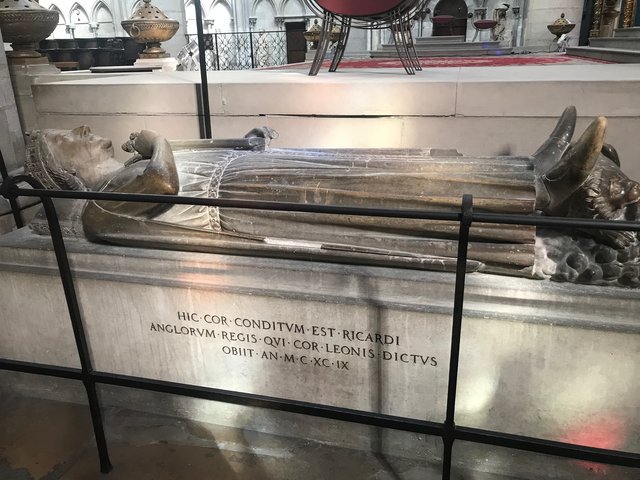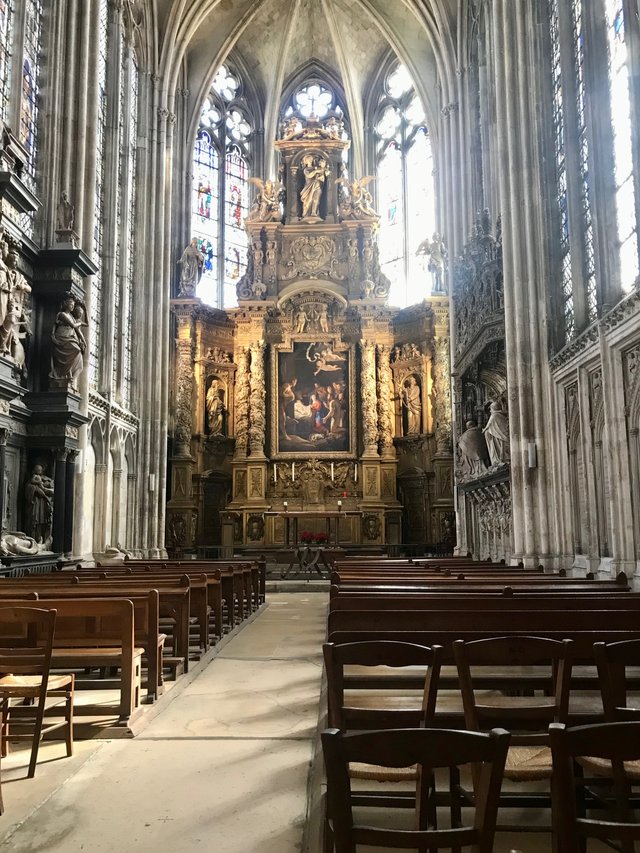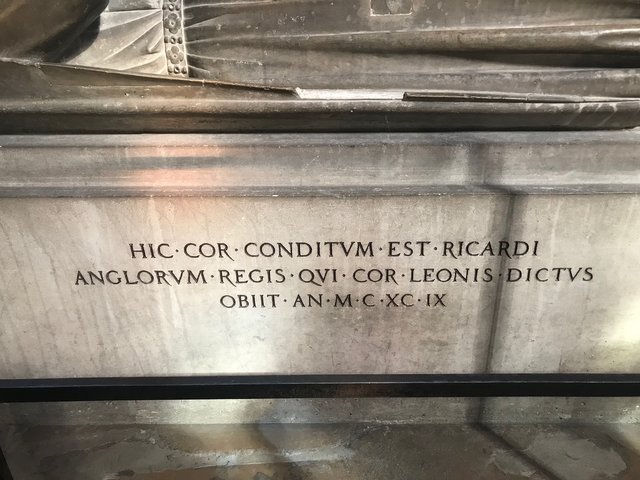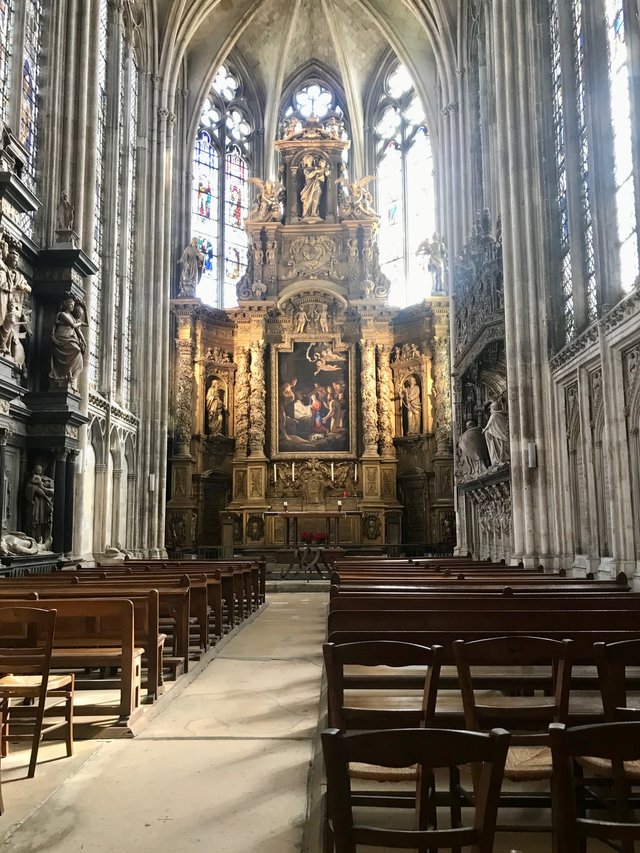The Heart of King Richard the Lionheart lay in Rouen Cathedral
You may find it heartless, but after his death in 1199, King Richard I of England (Richard the Lionheart) was divided up. Literally. As a result, the heart of King Richard the Lionheart lay in Rouen Cathedral.

Despite conducting many dangerous and harrowing military campaigns abroad, King Richard I died by an arrow in south-central France just before the 13th century. Shot in the shoulder by a vengeful peasant boy, the resulting wound became infected. The King died of sepsis a week later. It seems Richard had killed the boy's father and brothers during various revolts. And so, in another David and Goliath moment in history, it seems a mere lamb took down the mighty lion.
Following Richard's death, his body shared the fate of so many famous folks in this period; good-intentioned dismemberment. His organs and intestines were removed and buried in Châlus, France, where he had died. The rest of his corpse, sans heart, was taken to Fontevraud Abbey in Anjou, France, and buried alongside his father.

Richard's heart, however, was sent north to Normandy. Here, in Rouen Cathedral, it was interred in his likeness and set alongside the cavernous nave of the church. It remains there to this day.
Why cut up and distribute the body? I suppose that in a time bereft of photography, not to mention literacy, if you wanted a little memento of your favorite person, you need only cut off a hunk and build a memorial.

The stone tomb bears the inscription: "Hic cor conditum est Ricardi Anglorum Regis qui cor leonis dictus obiit an MCXCIX."
Translation: Buried here is the heart of Richard King of the English, who was called Lionheart. Died in 1199.
Richard the Lionheart was King of England from 1189-1199. One of the most revered regents in English history, he was a leader during the Third Christian Crusades against the Muslim lands in Jerusalem. Richard was also made Duke of Normandy in 1189, and this sets the premise for his partial interrnment in Rouen, capital of Normandy, France.
Richard's rise to the English throne was rather improbable for several reasons. First, as he was the third of five sons to King Henry II, his only path to King led through two older brothers. Fortunately for Richard, his oldest brother died at three years of age. The next in line, Henry the Young King, died from dysentery at 28. And so, with that, the Lionheart became heir to the throne.
Second, Richard, and his older brother, waged war against their father, as well as with each other. Squabbles over lands, titles and royal streams of income led to frequent battlefield engagements. This warfare eventually led to Henry the Young King and King Henry II's deaths and Richard's coronation.
Richard I spent most of his adult life in France when not away on military engagements. He was fluent in French and credited with extending the feudal rule in Normandy throughout his lifetime.
As King, he built Château Gaillard, a castle high atop Les Andelys, between Rouen and Paris. This was a strategic position against Philip II, King of France, based nearby in Paris and was his chief rival. And so, with close ties to the area, it is understandable that they might have wanted a piece of the good King with which to remember him. And, perhaps, to generate a bit medieval tourism.
As King, Richard led the Third Crusade in the Holy Lands. His military prowess and bravery were already well established, however. Richard had directed his first army at 16 years of age and earned the nickname Lionheart while putting down several rebellions against his father's rule in France.

To be honest, I had entered the cathedral unaware of the history. It was quiet and practically deserted. As I explored the many small chapels set along the exterior walls, I noticed that there were many tributes to previous worshipers and leaders of the church. The realization that these were epitaphs came slowly.
As I circled the nave and crossed past the choir, I noticed a row of stone tombs in the shape of their inhabitants. Four Dukes of Normandy lay at rest in a series.
The engraving on each crypt is in Latin. However, thanks to my Freshman Latin teacher, I could pick out the general idea on each of these edifices, if not precisely the specific content. And that's when I spied Richard the Lionheart. Thanks, too, to my 8th-grade history teacher...
When I read here lies his heart, I'll admit that I thought it to be a poetic expression. But no. As usual, my research on the matter once home filled in the blanks and misconceptions from my journey. They mean it quite literally. The heart of King Richard the Lionheart lay in Rouen Cathedral.
Just his heart.
Cheers!
All photos taken by the author on iPhone 7.

Congratulations @braveboat! You received the biggest smile and some love from TravelFeed! Keep up the amazing blog. 😍 Your post was also chosen as top pick of the day and is now featured on the TravelFeed.io front page.
Thanks for using TravelFeed!
@smeralda (TravelFeed team)
PS: You can now search for your travels on-the-go with our Android App. Download it on Google Play
Biking and walking combo tours offer the best of both worlds. These tours start with a bike ride through the city, followed by a walking tour of specific neighborhoods. This combination allows visitors to amsterdam one day trip cover more ground while still enjoying an intimate exploration of Amsterdam's streets.
Thyroid function is supported by the nutrient-rich properties of Shiitake mushrooms. Shiitake contains essential vitamins and minerals that living holistic wellness support thyroid health.